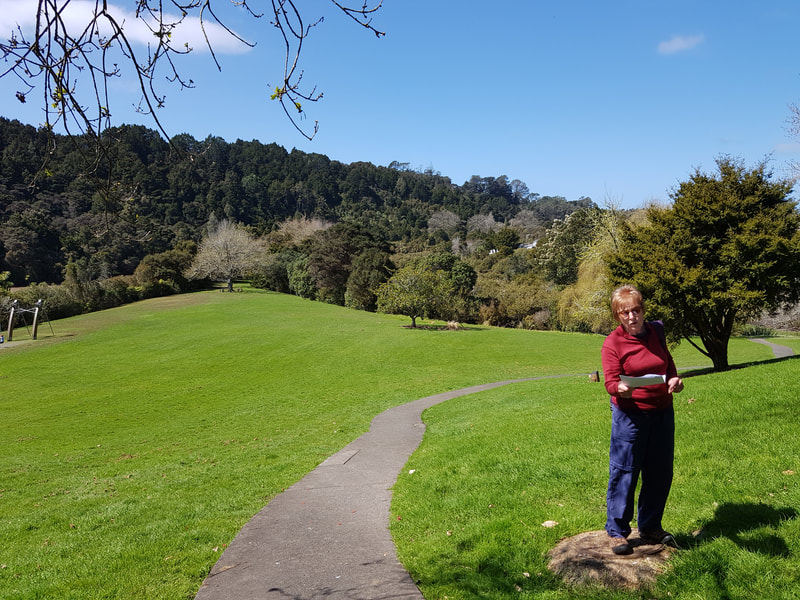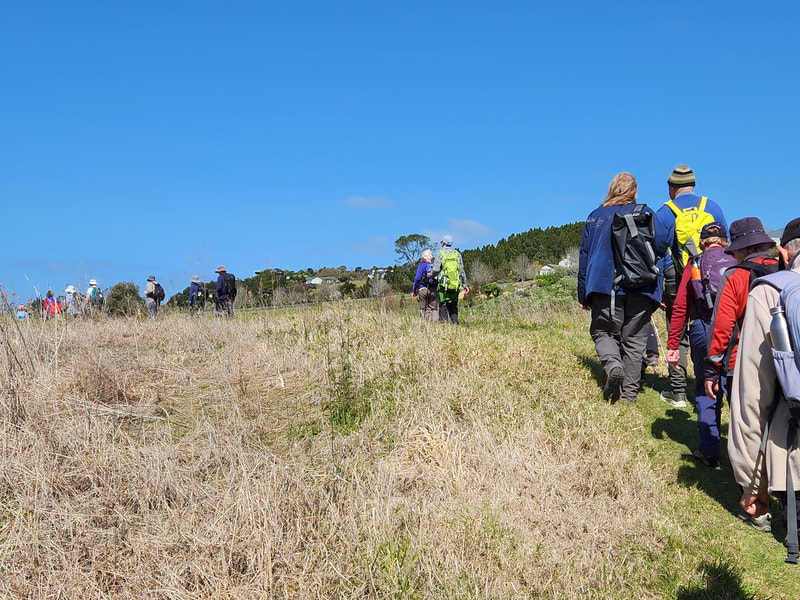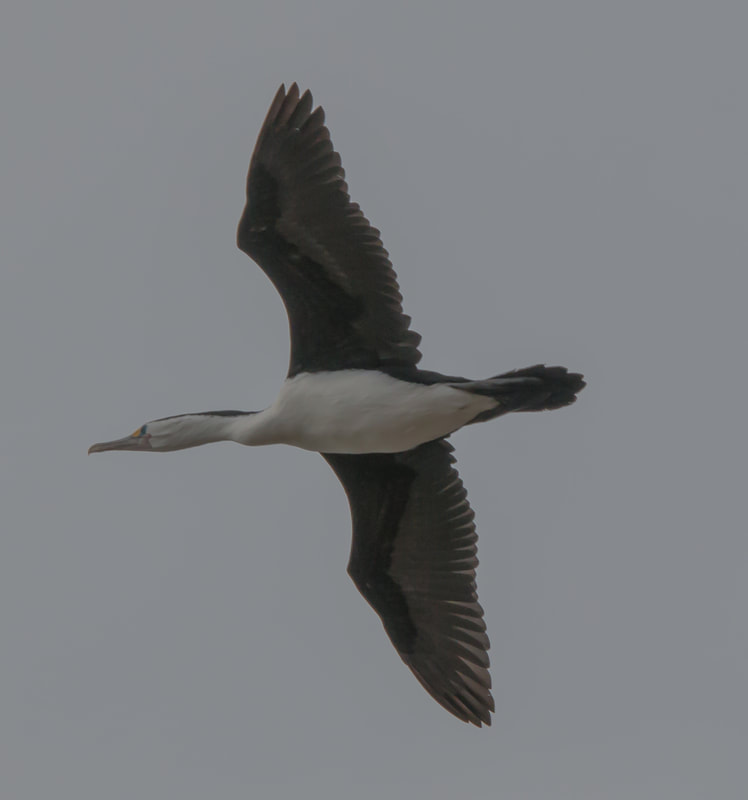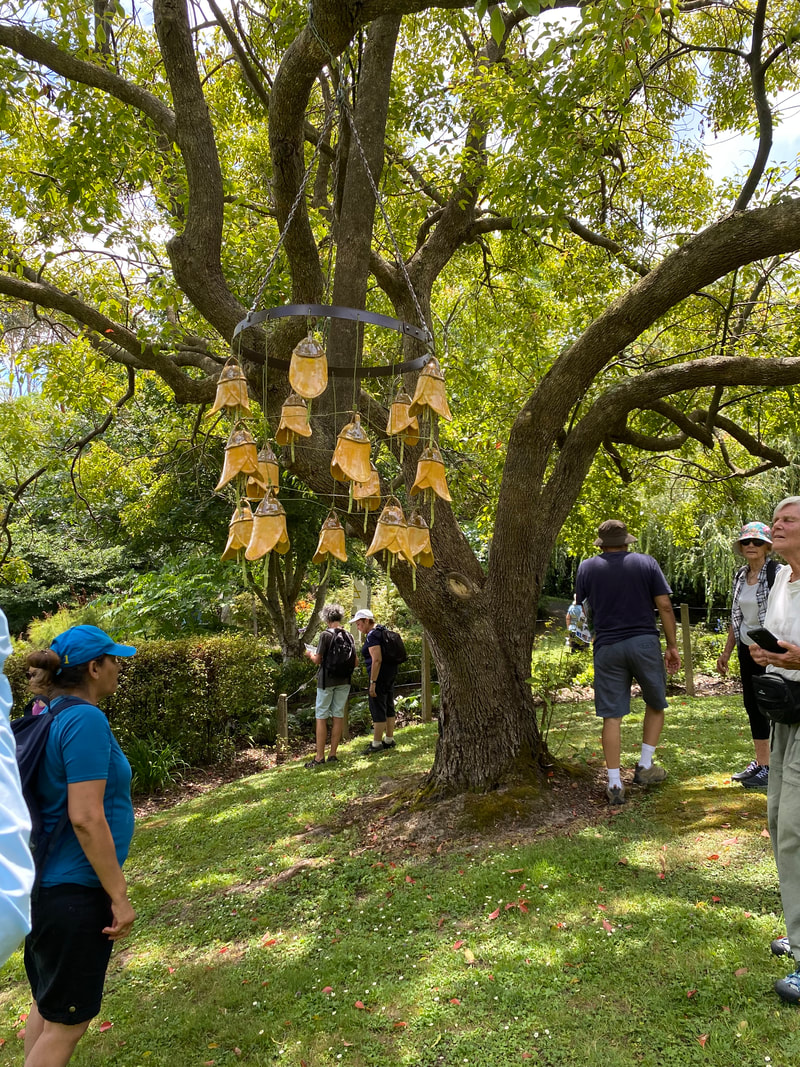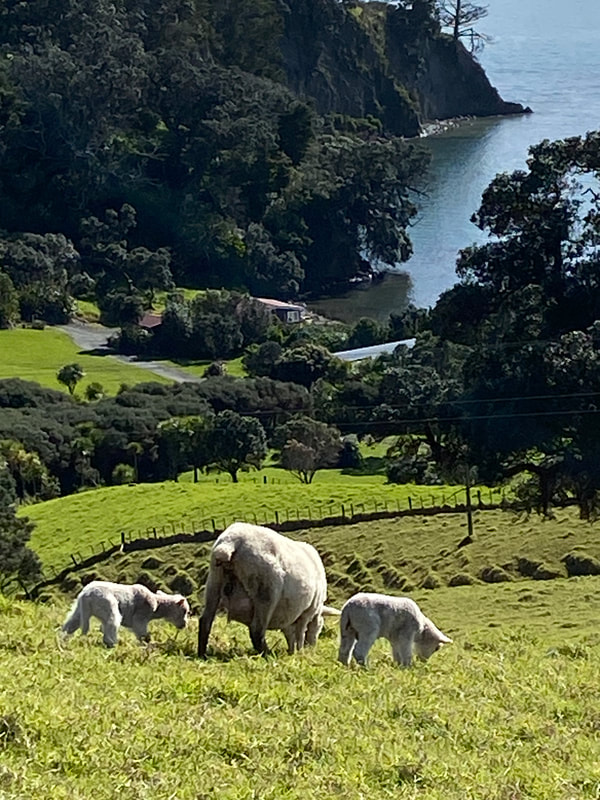TRIP REPORTS: August - September 2023
17 September 2023- Warkworth
 A kauri with many Astelias perched on its upper branches.
A kauri with many Astelias perched on its upper branches.
Our day was spent in the Warkworth area, the township being 63km north of Auckland.
Once again, we won the gamble with the weather for our trip. The sun shone and not a drop of rain fell. The quick smooth drive on the new motorway soon had us at the entrance to Kowhai Park for the first walk of the day. The park is dominated by tawa and titoki but also has large matai, totara and kauri trees.
The mature kowhai trees that were once plentiful have now reached the end of their lifespan but kowhai saplings are being planted to replace them. Having read the information available on the panels provided and noted the large rimu tree planted by Lord Bledisloe in 1934, we separated into an A and a B group.
The A group walked the track up to the Heritage Lane entrance to the park beside the stream, admiring the huge totara on our left as well as the epiphytes and fragrant ferns ( mokimoki) on the way. Tangles of supplejack were noted (koreao) weaving upwards to seek the light. While we waited for the others to move through the boot cleaning stations, tui and fantails entertained us.

Morning tea at the top of the track which opened out onto a sloping meadow, was eaten in the glorious sunshine whilst admiring the stand of bush on the hillside opposite.
The B group had earlier enjoyed morning tea at the tables in the car park and had then set off to see the lime kilns and walked a shorter loop after the A’s departed.
To get to the walks for the next part of our day we drove to Warkworth township. Here we strolled on the boardwalk by the river up to the Elizabeth Street Bridge and the town weir. Of interest while walking in this area by the Mahurangi River was the moored scour Jane Gifford, a heritage vessel built in 1908. It is the sole remaining fully rigged sailing scow. Many club members remembered the wonderful river trip we took for our end of year Christmas celebration several years ago. After a stop for photographs and listening to information read out regarding the scow and its restoration, we moved on to Lucy Moore Memorial Park.
|
At the park Sandra read us some background details telling us how Lucy Moore graduated from Auckland University with a MSc in 1929 and became recognized for her eminence in the world of science. This park was a pleasant place for us to have lunch with a view of the Mahurangi River only a couple of minutes away.
|
The Wilson Cement works, our next destination, was founded by Nathaniel Wilson operating from 1872 to 1928. The works played a vital role in the development of Warkworth’s economy. Today the whole complex makes a picturesque ruin next to the lake formed by the flooded quarry alongside. The silhouette of the ruins against the blue sky presented a scene many of us wanted to photograph.
A last short walk at Parry Kauri Park ended our day. The park named after Harry Parry a pioneer of the area who together with local photographer/businessman Tudor Collins, the Kauri Bushmen’s Association and public subscription, were responsible for purchasing the land for public use. The two giant kauri trees within the park are estimated to be between 700 and 800 years old. The half hour bush walkway on the newly replaced boardwalk took us through regenerating native bush to a bird feeding platform.
The late afternoon light filtering through the trees to the ferns below created an impressive image. On the sides of the boardwalk the names of the trees helped us identify the species that had been planted.
Before the drive home it was decided that an ice cream at the park shop would finish the day nicely.
Before the drive home it was decided that an ice cream at the park shop would finish the day nicely.
A big thank you to Fiona for carrying the day in spite of the second (injured) leader's absence, with some help from Sandra.
Text: Fiona
Photographs: Barbara, Cheryl, Praemi and Robyn
Text: Fiona
Photographs: Barbara, Cheryl, Praemi and Robyn
3 September 2023 - Eastern Reserves
After an introduction by Gilbert, today's leader, 29 members disembarked the bus at Glover Park and made their way to the Waitara Road entrance to Churchill Park (named after Winston Churchill when the park was created in 1945). The park is currently a small working farm and as well as open pasture, it offers areas of bush and woodland.
 Churchill Park
Churchill Park
A prominent landmark in the area is the St Heliers Water Tower, built on a tuff ring formed from the nearby volcanic explosion. The water tower was constructed in 1936 and is still owned and operated by Watercare.
Our morning tea stop was at Roberta Reserve – adjacent cafes were certainly a drawcard, and there was plenty of seating overlooking a very busy playground.
Continuing our walk across Roberta Reserve, we headed towards Tohuna Torea Reserve.
Tahuna Torea includes a long sand bank which extends out into the Tāmaki Estuary. It also has a tidal lagoon with mangrove scrub, freshwater wetlands and regenerating native forest and scrub. The area provides a mix of marine, intertidal, freshwater and terrestrial habitats.
Tahuna Torea includes a long sand bank which extends out into the Tāmaki Estuary. It also has a tidal lagoon with mangrove scrub, freshwater wetlands and regenerating native forest and scrub. The area provides a mix of marine, intertidal, freshwater and terrestrial habitats.
 Tahuna Torea Reserve
Tahuna Torea Reserve
Tahuna Torea Nature Reserve (“the gathering place of the oyster catchers”), certainly offered prolific birdlife. A few that we saw – grey warbler, white-faced heron, cormorants, royal spoonbills, paradise ducks, pied stilts, oystercatchers, pukekos and even black swan cygnets.
We walked out to the end of the sandspit before retracing our steps along the lagoon walk and the bank of the estuary to Wai O Taiki Nature Reserve. This smaller reserve also offered great estuary views, plenty of birdlife and a great mixture of exotic and native bush.
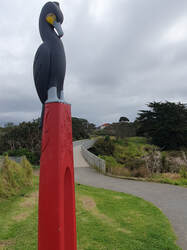
Our next destination, the 41ha Point England Reserve. It stretches along the Tamaki river and it encompasses varied landscapes, including bird nesting grounds and farmland. It also includes facilities such as the Glen Innes Community Pool and Recreation Centre, plus BBQ areas and picnic tables. The perfect spot for us to stop for lunch!
The walkway runs along the length of the reserve and will become part of the 11km Tamaki Loop that is currently being developed.
It was at this point we realised the wind was picking up and the clouds were rolling in. It was time to pick up the pace!

From here, it was a good wide path to our final destination where the bus was waiting at the Panmure Yacht and Boating.
Gilbert, Jenny and Dawn put a great day together for us - many, many thanks!
Text: Linda
Photos: Barbara and Linda
6 August 2023 - Scandrett Regional Park
Our luck was in; calm sunny weather, the ranger was able to meet us to open Scandrett Homestead and our trusty driver Oki managed to navigate the bad road conditions without any mishaps. It certainly had been a wise decision to change at Warkworth from our usual big bus to a smaller one more suitable to the conditions encountered.
On reaching our destination the group dispersed to investigate the homestead and the restored farm buildings, the contents of which reflected the difficulties of farming, in such a then remote region in the past. For the interested walkers several information panels could be read to enlighten them on life in and around Scandrett Homestead.
Morning tea to restore energy levels was enjoyed at the picnic tables nearby before we set off on our walk. On such a clear day the track to Mullet Point lived up to the words used in the park brochure of “ expansive sparkling waters.” This being the translation from the Māori word Purahurawai. From Mullet Point we climbed up the hill to a suitable resting place where Sandra read out some interesting history of the area. We then ascended to the ridgeline and could appreciate from the view what an advantageous position it would have been for Māori during their time of occupation.

Walking on undemanding terrain, through a grove of mature pohutukawa along the ridge, we took time to admire large, well nourished native pigeons( kererū) and numerous fantails (pīwakawaka.) Fiona read out some further information about the fantails to add to what we already know.
The Mullet Point Track joined the Scandrett Bay Track giving a downhill path to the beach at the bay. On the way it was delightful to see the lambs gamboling in the sunshine and at the beach to see the mullet thrashing in the water while sea birds dived after them. Here our keen photographers managed to capture shots of oyster catchers and dotterels too without disturbing them.
The Mullet Point Track joined the Scandrett Bay Track giving a downhill path to the beach at the bay. On the way it was delightful to see the lambs gamboling in the sunshine and at the beach to see the mullet thrashing in the water while sea birds dived after them. Here our keen photographers managed to capture shots of oyster catchers and dotterels too without disturbing them.
We took in a quick visit to Highfield Garden Reserve on the way home. The sweeping views dotted with islands and several short walks in the reserve make it a pleasant place to wander if you have the time. We set off to find the resident donkeys but at first they were quite elusive, lurking at the back of their paddock down by the road entrance. Eventually a hungry one slowly approached the group and munched happily on the apples and carrots offered.
As a few raindrops started to patter down it was time to walk back up the hill to the bus and head home.
Many thanks to Fiona and Sandra, our leaders, for a stunning day.
Text: Fiona Photos: Catherine, Shona, Sue.
Many thanks to Fiona and Sandra, our leaders, for a stunning day.
Text: Fiona Photos: Catherine, Shona, Sue.






